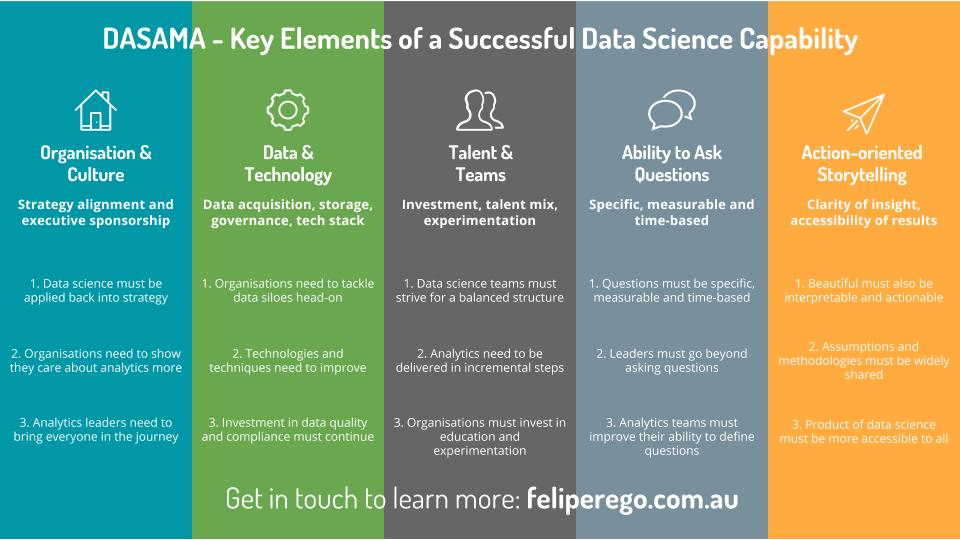DASAMA™ - Data Science and Analytics Maturity Assessment model
The DASAMA™ model has been developed to help organisations gain visibility on their data science and analytics journey.
4 mins reading time
In today’s world, data science and analytics have become an important source of competitive advantage. With large amounts of data being generated at an increasing rate, organisations are seeking best-in-class approaches to building, managing and enhancing their analytics and data science capabilities to increase performance and reduce inefficiencies.
Over the years, I’ve seen and worked with many organisations with remarkably different levels of maturity when it came to their ability to build and manage successful data science and analytics capabilities.
That’s one of the reasons I’ve been developing a framework to assess an organisation’s ability to build and manage a successful data science capability. I call it the DAta Science and Analytics Maturity Assessment (DASAMA™) model.
The DASAMA™ model has been developed to help organisations gain visibility on their data science and analytics journey. More specifically, the DASAMA™ allows data, technology and analytics leaders as well as analysts and data scientists to gauge their organisation’s maturity across important dimensions, providing a framework for organisations to learn where they are in their data science and analytics journey and where they have to concentrate future efforts to take their initiatives to a more mature level.
The DASAMA model is developed with clients through both a survey and an in-depth interview. It consists of 30 core questions relating to how well an organisation’s data science and analytics practice is conducted in light of important themes:
-
Organisation & Culture: This section gauges an organisation’s ability to translate high-level strategic objectives into data science and analytics initiatives as well as the ability for data science and analytics leaders to translate strategy into workable initiatives that end up feeding back into strategy for direction and / or course correction. It also gauges the level of support and endorsement managers and leaders give to data science and analytics initiatives. Specifically, it assesses empowerment, exposure and structure given to analysts and analytics leaders to be able to deliver value to the business through data and analytics.
-
Data & Technology: This section assesses an organisations ability to identify, store, expose, dispose and utilise data in light of privacy and other security concerns. It also gauges an organisation’s ability to deploy and manage an appropriate technology stack suitable for modern data science and analytics.
-
Talent and Teams: This section gauges an organisation’s ability to hire, manage and promote a diverse range of analytical skills in the team. It assesses the appetite for experimentation, motivation and inclusion of talent across many different profiles.
-
Ability to Ask Questions: This section gauges an organisation’s ability to ask questions that are specific, measurable, and time-based. It assesses whether leaders incentivise their teams to ask specific, measurable and time-based questions as well as whether analysts are capable of translating high-level, ambiguous questions into specific, measurable and time-based questions.
-
Action-Oriented Storytelling: This section gauges an organisation’s ability to produce, package and present and consume analytical results that are both compelling and action-oriented. It assesses whether questions that have been posed were clearly answered in an unbiased manner as well as whether it allows the business to infer both quantities and percentages.
DASAMA™ simplifies and augments analytics strategy

The results of DASAMA™ can be delivered through both a report and a presentation/workshop. The outcome provides organisations with a clear set of focus areas in their analytics strategy.
The DASAMA™ model is targeted at leaders as well as data, business, technical analysts and data scientists. The format is based on questions asking respondent’s level of agreement across a variety of statements on a scale of 1 to 5 where 1 means respondents Strongly Disagree and 5 means respondents Strongly Agree.
To date, DASAMA™ has collected in-depth knowledge from dozens of organisations in Australia across marketing, sales, finance and digital leaders.
Responses collected through DASAMA™ are kept confidential and results do not provide information that can identify participating organisations. All data are combined with those of many other respondents and summarized to provide an additional layer of protection and anonymity.
If you’d like to participate or learn more about it, get in touch.